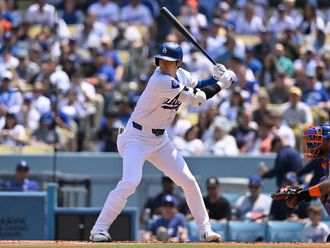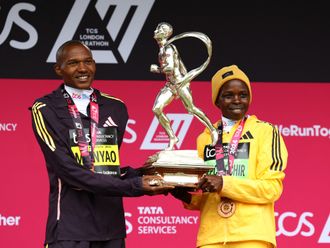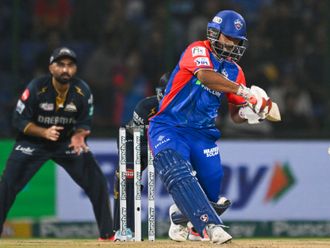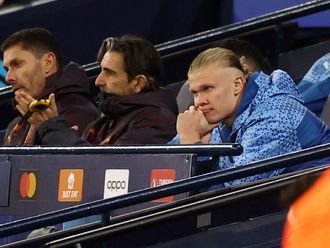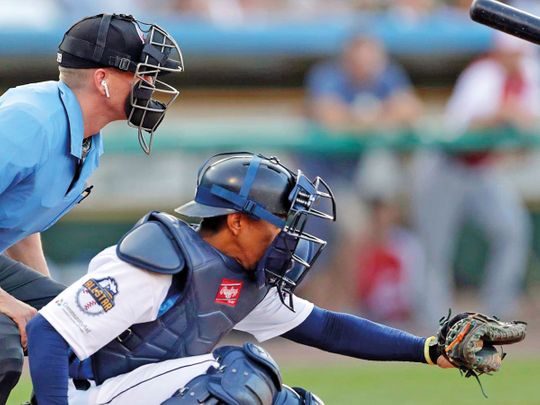
New York: The either long-dreaded or long-awaited arrival of digitally rendered ballpark justice has come to professional baseball. “Robot umpires” have arrived.
Except, they’re not really robots. They’re human umpires wearing a Bluetooth-connected earpiece, connected to an iPhone, connected to a software programme in the press box. The software doesn’t make every call, just balls and strikes. And if it’s wrong, the human umpire can step in to overrule the programme, and his decision, not the software’s, is final.
The Atlantic League, an independent circuit with seven teams on the East Coast and one in Texas, will become the first American professional baseball league to let a computer call balls and strikes at its All-Star Game on Wednesday night in York, Pennsylvania.
“It’s amazing how good these robots look. They look just like the actual umpires,” league president Rick White joked in a phone interview before the game. “I think once people actually see this happening, they’re going to realise it’s not that big a deal.”
And during the game, it wasn’t. Home plate umpire Brian deBrauwere wore an Apple AirPod in his right ear, which connected to an iPhone in his back pocket. That communicated ball or strike calls from a computer in the press box. Players shook their heads at a couple of pitches each inning and acknowledged the system’s general criticism — it awards higher and lower strikes that human umpires generally do not — but overall they didn’t have any major qualms with the electronically enabled strike zone.
“This strike zone is different than what every player has known in the past,” said York Revolution pitcher Mitch Atkins, who started the game for the Freedom Division team.” It has to be down to an exact science,” Long Island Ducks second baseman L.J. Mazzilli said. “You have to roll with it.”
League officials have quietly tested software, created by sports data firm Trackman and provided by Major League Baseball, for weeks during real games in New Britain, Connecticut, and Bridgewater, New Jersey. For a few innings or an entire game, umpires have heard “ball,” “strike” or “did not track” through the earpiece, then conveyed Trackman’s call, only overturning the software on a technical glitch. Home plate umpires continue to rule on check swings, foul tips, catcher’s interference and plays at the plate. (While the programme has been provisionally tested, with managers being informed before the game when Trackman would be used, Wednesday’s All-Star Game begins the league’s formal roll-out.)
Officials have monitored everything from the time it takes the software to communicate “ball” or “strike” into the umpire’s ear to the software’s loyalty to baseball’s sacrosanct strike zone: “That area over home plate the upper limit of which is a horizontal line at the midpoint between the top of the shoulders and the top of the uniform pants, and the lower level is a line at the hollow beneath the knee cap,” according to the Major League Baseball rule book.
Even during the testing period, the technology has changed. Umpires first experimenting with the system were equipped with a radio-receiver belt pack. Now, they slip an iPhone connected to a WiFi network into a back pocket.
The Atlantic League is set to install the system, run via a small panel placed in an elevated position behind home plate, in each of its club’s ballparks for use in the second half of its 140-game regular season. Then baseball’s next generation of electronic transformation will have arrived, and it will be more subtle than you think, unless you can spot a single Apple AirPod in the home plate umpire’s ear behind his mask.
“I have seen this coming. It’s inevitable,” Atlantic League umpire Derek Moccia said. “The game is changing. Baseball needs to speed up to keep up with the world. And if you want to be on board with this, you have to keep up. The game is bigger than you, bigger than any player.”
The experiment is part of a three-year agreement with MLB that allowed big league officials to install experimental rules in the Atlantic League to study their effects on game play, strategy, tempo and prospect development. In return, MLB promised to “enhance its scouting coverage of the Atlantic League” and to install hardware to enable advanced analytical study of players.
Some of those rule changes include a prohibition against mound visits, a ban of defensive shifts, a three-batter minimum for new pitchers and larger bases (18-by-18 inches, rather than 15-by-15). In the second half of the season, the league will allow batters to steal first base: Any pitch on any count not caught in flight will be considered a live ball, and a batter may run to first base, similar to a dropped third strike.
Based on the results, MLB Commissioner Rob Manfred could consider implementing new rules after the league’s labour agreement expires in 2021. Manfred has reportedly already discussed instituting a 20-second pitch clock. The Atlantic League already employs a 12-second pitch clock.
Much of the tension around the rule changes for the developmental league — which baseball insiders liken to Class AAA in affiliated minor league baseball — has focused on the action behind the plate as American sports’ most analogue game continues a steady creep toward the digital world.
Batsmen in baseball’s earliest iterations used to order the pitcher where they wanted the ball thrown (low, high, or “fair” — right down the middle), and umpires would declare the pitch a ball or strike in a much smaller zone. Now, a computer will judge balls and strikes in a preprogrammed strike zone that hitters, pitchers, coaches and umpires alike say has changed decadeslong expectations.
Although professional umpires are overwhelmingly consistent, each ump’s strike zone has some natural variance. The game’s human element makes officials susceptible to gamesmanship, such as when a catcher “frames” a pitch with his mitt to make it appear more attractive, or when a batter feigns stepping away from an offering to make it appear inhospitably inside.
“When an umpire is having a bad day, they can’t wait for the electronic strike zone,” said Mauro Gozzo, manager of the New Britain Bees. “But when your pitcher is rolling and he’s not getting that call that he normally gets of that pitch three inches off the plate, that’s going to get some players upset.”
“I always tell people, ‘It could benefit me,’ “ Somerset Patriots reliever Nate Roe said. “It could benefit me as far as pitch location or pitch break. I’m trying to stay very positive about the whole thing.”
Atlantic League players, coaches and umpires who spoke with The Washington Post said they favour the new software. Players and coaches lauded the system’s consistency and predicted it would end generations of bickering over balls and strikes.
“If a hitter or pitcher has an argument, who are they necessarily going to argue with anymore?” Somerset pitching coach Jon Hunton said. “There’s never been a pitch in baseball that’s ever been overturned from a ball to a strike or a strike to a ball.”
Umpires who have used the system said that although Trackman makes their jobs slightly more mechanical, it helps them call a fair game.
“I believe that I’m doing a decent job, but now I’m doing it with Trackman,” Baker said, “and that’s another tool I’ll have to help me.”
The consensus about the Trackman system from league officials, players and coaches is that it is more lenient on height but stricter on width. The software has called high pitches for strikes that many umpires consider too high. Breaking pitches that bounce in front of the catcher before crossing home plate have also been called strikes because the software has detected that the ball crossed the front of the plate even with the batter’s knee.
“I try to think that I have a good judgement of the strike zone, and in terms of consistency, it’s just minor differences between my zone and the Trackman zone,” umpire Calvin Baker said. “So do I trust my zone better? Absolutely.”
“I make a joke that if Trackman wants to stay in this league, it better tighten up,” Moccia said. “The players have patience. They want to be part of [bringing more technology into baseball] just like us umpires be a part of it, but that patience at some point is going to wear thin.”



